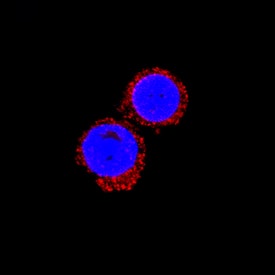Equine IL-1 beta/IL-1F2 Antibody
R&D Systems, part of Bio-Techne | Catalog # MAB33401

Key Product Details
Species Reactivity
Equine
Applications
Immunocytochemistry
Label
Unconjugated
Antibody Source
Monoclonal Mouse IgG1 Clone # 608714
Product Specifications
Immunogen
E. coli-derived recombinant equine IL-1 beta/IL-1F2
Ala116-Ala268
Accession # Q28286
Ala116-Ala268
Accession # Q28286
Specificity
Detects equine IL-1 beta/IL-1F2 in direct ELISAs. In direct ELISAs, 100% cross‑reactivity with recombinant canine, guinea pig, mouse, rat, and porcine IL‑1 beta is observed and 10‑50% cross‑reactivity with recombinant feline, human, rabbit, and rhesus IL‑1 beta is observed. Approximately 20% cross‑reactivity with recombinant mouse (rm) IL‑36 alpha and no cross‑reactivity with recombinant human (rh) IL‑36 alpha, rhIL‑36 gamma, rhIL‑1F10, rhIL‑36Ra, rmIL‑1Ra, rmIL‑18, or rmIL‑36 beta is observed.
Clonality
Monoclonal
Host
Mouse
Isotype
IgG1
Scientific Data Images for Equine IL-1 beta/IL-1F2 Antibody
IL‑1 beta/IL‑1F2 in Equine PBMCs.
IL-1 beta/IL-1F2 was detected in immersion fixed equine peripheral blood mononuclear cells (PBMCs) using Mouse Anti-Equine IL-1 beta/IL-1F2 Monoclonal Antibody (Catalog # MAB33401) at 25 µg/mL for 3 hours at room temperature. Cells were stained using the NorthernLights™ 557-conjugated Anti-Mouse IgG Secondary Antibody (red; Catalog # NL007) and counterstained with DAPI (blue). Specific staining was localized to cytoplasm. View our protocol for Fluorescent ICC Staining of Non-adherent Cells.Applications for Equine IL-1 beta/IL-1F2 Antibody
Application
Recommended Usage
Immunocytochemistry
20-30 µg/mL
Sample: Immersion fixed equine peripheral blood mononuclear cells (PBMCs)
Sample: Immersion fixed equine peripheral blood mononuclear cells (PBMCs)
Reviewed Applications
Read 1 review rated 5 using MAB33401 in the following applications:
Formulation, Preparation, and Storage
Purification
Protein A or G purified from hybridoma culture supernatant
Reconstitution
Sterile PBS to a final concentration of 0.5 mg/mL. For liquid material, refer to CoA for concentration.
Formulation
Lyophilized from a 0.2 μm filtered solution in PBS with Trehalose. *Small pack size (SP) is supplied either lyophilized or as a 0.2 µm filtered solution in PBS.
Shipping
Lyophilized product is shipped at ambient temperature. Liquid small pack size (-SP) is shipped with polar packs. Upon receipt, store immediately at the temperature recommended below.
Stability & Storage
Use a manual defrost freezer and avoid repeated freeze-thaw cycles.
- 12 months from date of receipt, -20 to -70 °C as supplied.
- 1 month, 2 to 8 °C under sterile conditions after reconstitution.
- 6 months, -20 to -70 °C under sterile conditions after reconstitution.
Background: IL-1 beta/IL-1F2
References
- Allan, S.M. et al. (2005) Nat. Rev. Immunol. 5:629.
- Boraschi, D. and A. Tagliabue (2006) Vitam. Horm. 74:229.
- Kornman, K.S. (2006) Am. J. Clin. Nutr. 83:475S.
- Isoda, K. and F. Ohsuzu (2006) J. Atheroscler. Thromb. 13:21.
- Kato, H. et al. (1997) Vet. Immunol. Immunopathol. 48:221.
- Howard, R.D. et al. (1998) Am. J. Vet. Res. 59:704.
- Martinon, F. and J. Tschopp (2007) Cell Death Differ. 14:10.
- Kato, H. et al. (1996) Gene 177:11.
Long Name
Interleukin 1 beta
Alternate Names
IL-1b, IL-1F2, IL1 beta, IL1B
Entrez Gene IDs
Gene Symbol
IL1B
UniProt
Additional IL-1 beta/IL-1F2 Products
Product Documents for Equine IL-1 beta/IL-1F2 Antibody
Product Specific Notices for Equine IL-1 beta/IL-1F2 Antibody
For research use only
